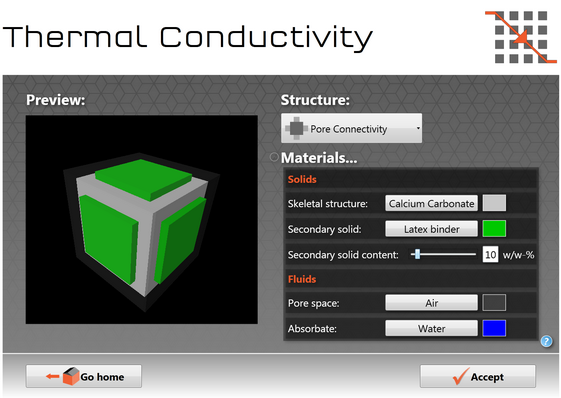The thermal conductivity screen allows you to set parameters required to model the effective thermal conductivity of the porous medium. Your medium may consist of a maximum of two solids and the pore space can contain up to two fluids. The structure type defines how solids and fluids are arranged in respect to each other. Note that the effective thermal conductivity is calculated based on the current state of a unit cell, i.e. effective thermal conductivity will change after a fluid uptake operation.

Mapping of the thermal conductivity cells
The effective thermal conductivity is calculated based on the local pore structure of the unit cell, which is defined by the volume of a single pore, plus half of the adjacent throat volume. Thus, each grid element in a PoreXpert unit cell, will act as a master to create a thermal conductivity cell of equivalent pore volume (shown in preview screen). The solid and fluid phases can be arranged in either one of two structural configurations.
Structure Type
Pore Connectivity
|
In the Pore Connectivity structure type, the primary solid is a central cubic phase, while fully surrounded by pore space. Thus the pore space effectively forms a continuous percolation path. A secondary solid can be added and arranged around the central phase as connecting "bridges". Pore connectivity mode usually delivers a lower boundary for the effective thermal conductivity due to the strong influence of the low conductive fluid phase. |
Solid connectivity
|
In Solid Connectivity mode, the central pore volume is surrounded by the solid phase(s). Since the solid phases form a continuous percolation path, solid connectivity mode delivers a upper boundary of the effective thermal conductivity of the medium. Note: In order to visualize the inner pore volume, the surrounding solids are shown transparently in the preview. |
Materials
Skeletal structure
Primary solid of the porous medium.
Secondary solid (optional)
Optional secondary solid, forming connecting bridges. Note: Because the volume of the secondary solid is based on weight percent of the primary solid, make sure the primary solid uses the correct material density. The secondary solid can be the same material as the primary solid.
Pore space
Material of the “empty” pores. The pore space content needs to be a fluid.
Absorbate
Can override the content material after a fluid uptake calculation. By default the material properties of the absorbing fluid are used.

